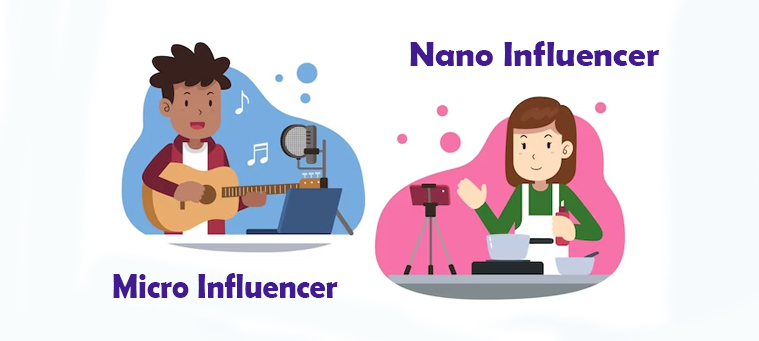Influencer marketing has exploded in recent years. So did the cost. But, while big names come with big price tags, micro-influencers have emerged as an invaluable alternative for brand partnerships.
Defined as having 1,000 to 100,000 highly engaged followers, micro-influencers bridge the gap between everyday consumers and celebrity influencers. They tend to focus on specific, niched topics and interact authentically with their audiences.
According to influencer marketing platform Upfluence, 60% of brands say their top goal in working with influencers is to increase awareness. Micro-influencers also deliver – they have 5-10X higher engagement rates compared to those with larger followings.
This article will explain the best practices for identifying, vetting, and collaborating with micro-influencers so you can incorporate them into your marketing strategy.

Why Micro-Influencers Matter

There are a few key advantages that make micro-influencers stand out compared to traditional celebrity influencers:
Niche focus
Rather than trying to appeal to a general audience, micro-influencers drill down into specific niches and verticals. This allows them to deeply connect with target audiences that directly align with a brand’s positioning. For example, an eco-friendly fashion line could partner with micro-influencers in sustainable living spaces rather than broadly lifestyle influencers.
Authentic engagement
Micro-influencers are approachable peers who cultivate personal connections with their followers. 82% of consumers are highly likely to follow a recommendation from a micro-influencer according to Experticity. This drives higher click-through rates and engagement on sponsored content.
Cost-effectiveness
While celebrity influencers can charge hundreds of thousands for a single promotional post, micro-influencers often work for free products or hundreds to a few thousand dollars. For new brands with limited budgets, partnering with multiple micro-influencers expands reach.
Before You Start: Set Your Strategy

The first step to exploring micro-influencer marketing is getting crystal clear on what you want to achieve. Here are a few tips:
Define your goals
Are you driving awareness? Conversions? Lead generation? Determine what specific metrics constitute campaign success upfront. This focuses efforts and helps track ROI.
Research your target audience
Conduct in-depth audience research to uncover demographics, interests, behaviors, and what social platforms they are most active on. This informs the type of micro-influencers that will resonate most.
Determine your budget
Factor in campaign duration, number of influencers, content expectations, and compensation structure to set an overall budget. Benchmark against similar campaigns in your industry.
Finding the Perfect Micro-Influencer Match

With a strategy in place, it’s time for the fun part—finding micro-influencers that perfectly fit your brand! Here are tactics to add them to your influencer network:
Leverage influencer marketplaces
Sites like Upfluence, Aspire, and PromotionalPact allow you to search for influencers using parameters like audience size, industry, location, and engagement metrics. Sort through options easily.
Attend relevant events
Look for industry events, local meetups, conferences, etc. where your target audience gathers. Connecting in person can help build strong relationships.
Pay attention to UGC and hashtags
Look for user-generated content around your branded hashtags and products. Engaged customers may have micro-influencer potential.
Tap into your own network
Ask your employees, partners, and existing influencers if they have micro-influencer connections who may be a fit. Leverage warm introductions.
Work with specialist agencies Influencer marketing agencies already have established networks and can leverage their expertise to find the right partners tailored to your brief.
Evaluate Potential Partners Holistically

Once you have a list of prospective micro-influencers, the next step is vetting them thoroughly. Consider factors like:
Content quality and aesthetics
Review the production value, consistency, and overall aesthetic of their content. Ensure it aligns with your visual brand standards.
Audience alignment
Look at audience demographics like age, gender, location, and interests. Do they match your target customer profile?
Values and messaging
Assess how they talk about products and brands. Do they share your brand values? Or have red-flag behaviors like aggressive follow-for-follow tactics?
Engagement metrics
Analyze likes, comments, click-through rates, and overall follower-to-engagement ratio. Higher rates show an engaged community.
Past brand partnerships
Evaluate their experience working with brands, particularly ones similar to yours. Case studies and reviews can provide useful context.
Building a Strong Micro-Influencer Partnership

Once you’ve identified promising micro-influencers, it’s time to make your outreach. Follow these best practices as you start your working relationship:
Be clear and set expectations upfront
Provide all partnership details like campaign length, content expectations, asset needs, mandatory disclosures, usage rights for their content, and compensation structure.
Allow creative freedom
Give micro-influencers room to inject their unique personality and creative style while providing brand guidelines. Offer support and feedback throughout content creation.
Track performance closely
Set up unique discount codes, landing pages and UTM links so you can monitor traffic, engagement, conversions and overall ROI driven by their content. Check in regularly on what’s working and what can be optimized.
Nurture long-term relationships
View micro-influencers as true collaborative partners, not just a one-time paid post. Explore ongoing campaigns, check in consistently, and grow the relationship over time.
Offer value from both sides
Promote their content across your social channels when appropriate to help expand their reach. Make it a priority that the partnership is rewarding for them too.
Micro-Influencers Are the Future
92% of people say they trust recommendations from other consumers over branded content, according to McKinsey. Micro-influencers represent authentic consumer voices. They can humanize your brand, drive engagement with niche audiences, and ultimately boost your bottom line.
Are you ready to add micro-influencers to the marketing mix? By taking a strategic approach, thoroughly vetting options, and building genuine partnerships, micro-influencer collaborations can become invaluable for driving results and growth.
Remember to stay focused on your unique goals, evaluate success, and iterate your influencer approach over time. Leading brands are already embracing the power of micro-influencers. With the right framework, it’s an achievable, affordable way to reach your target audience and move your business forward.

